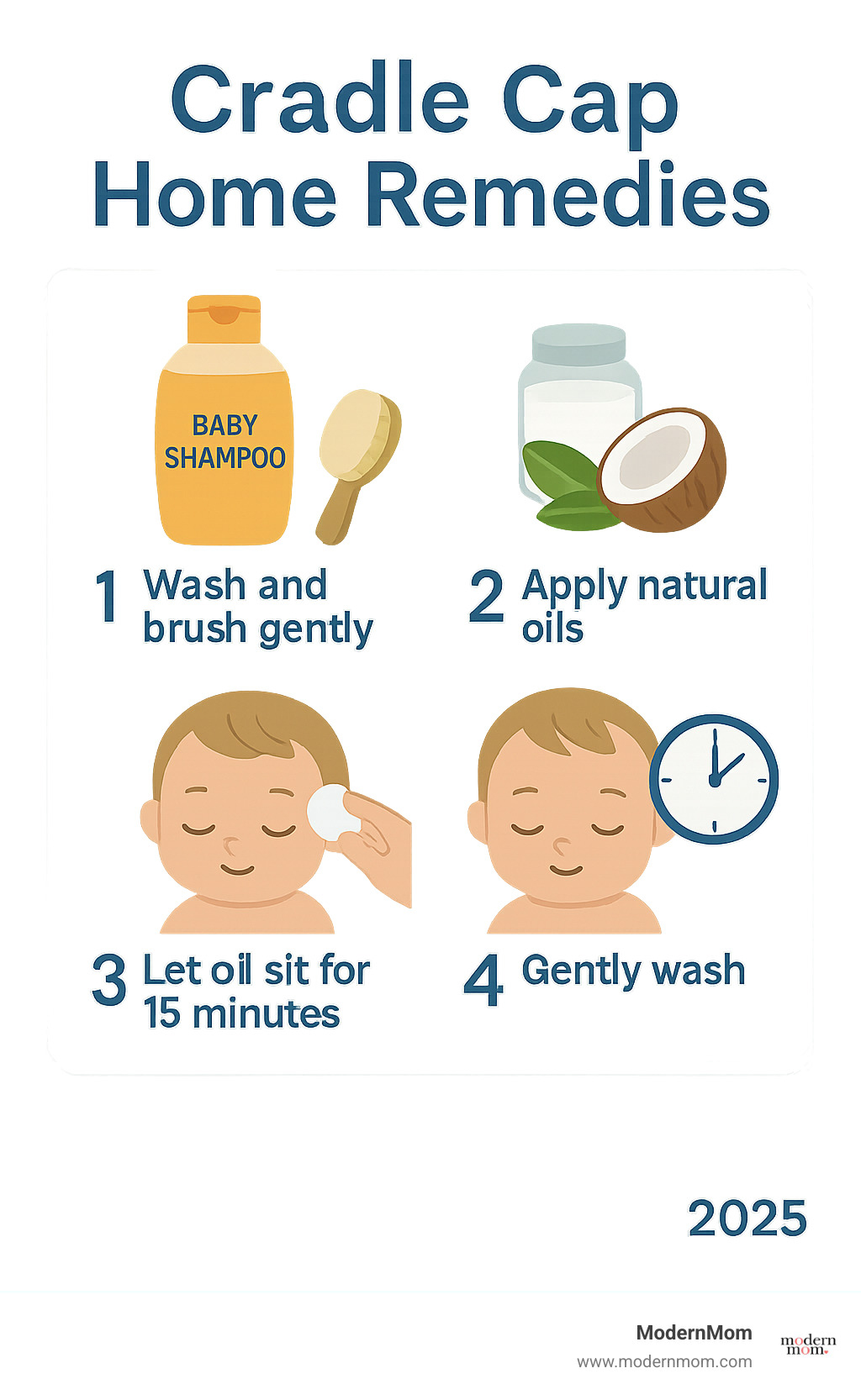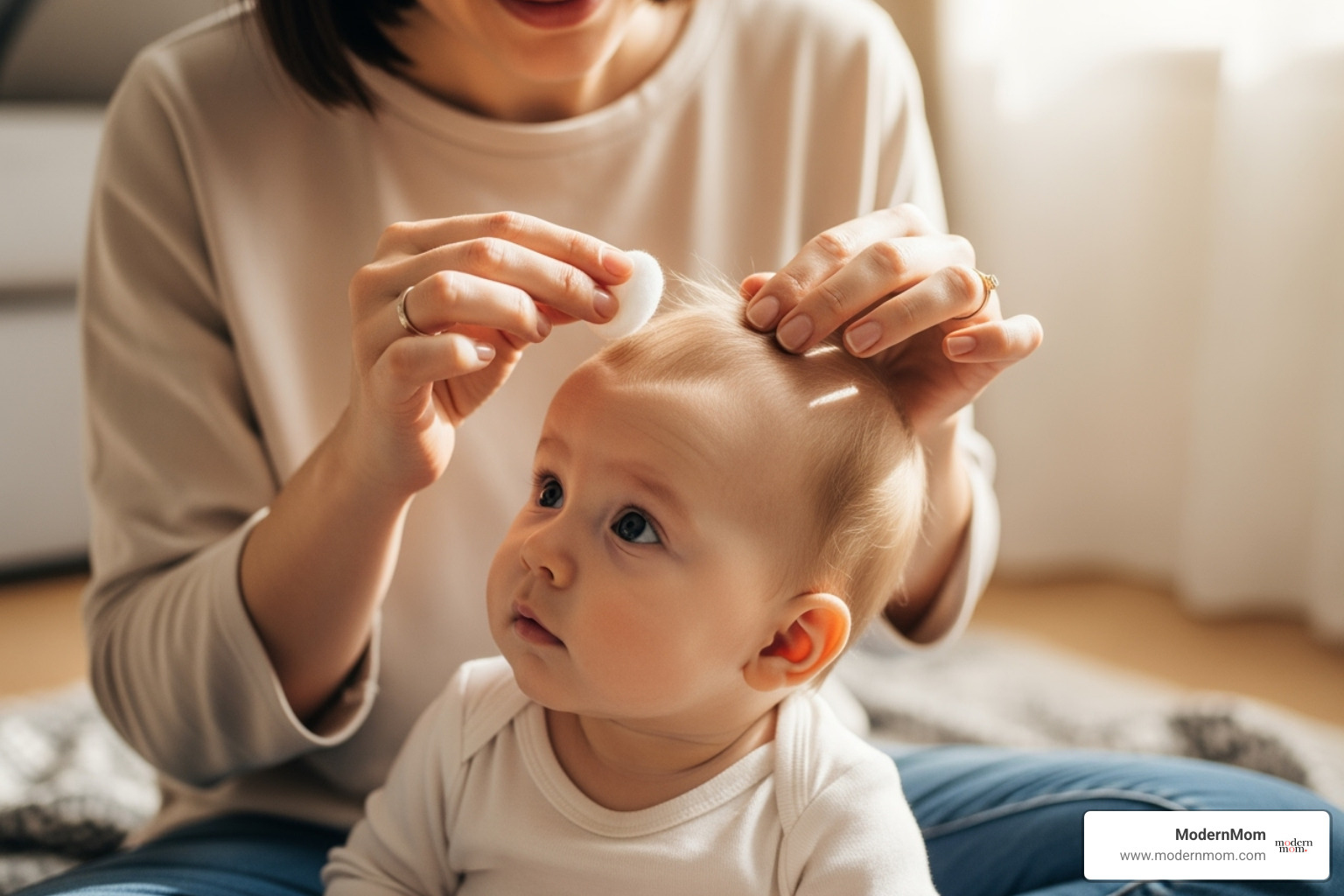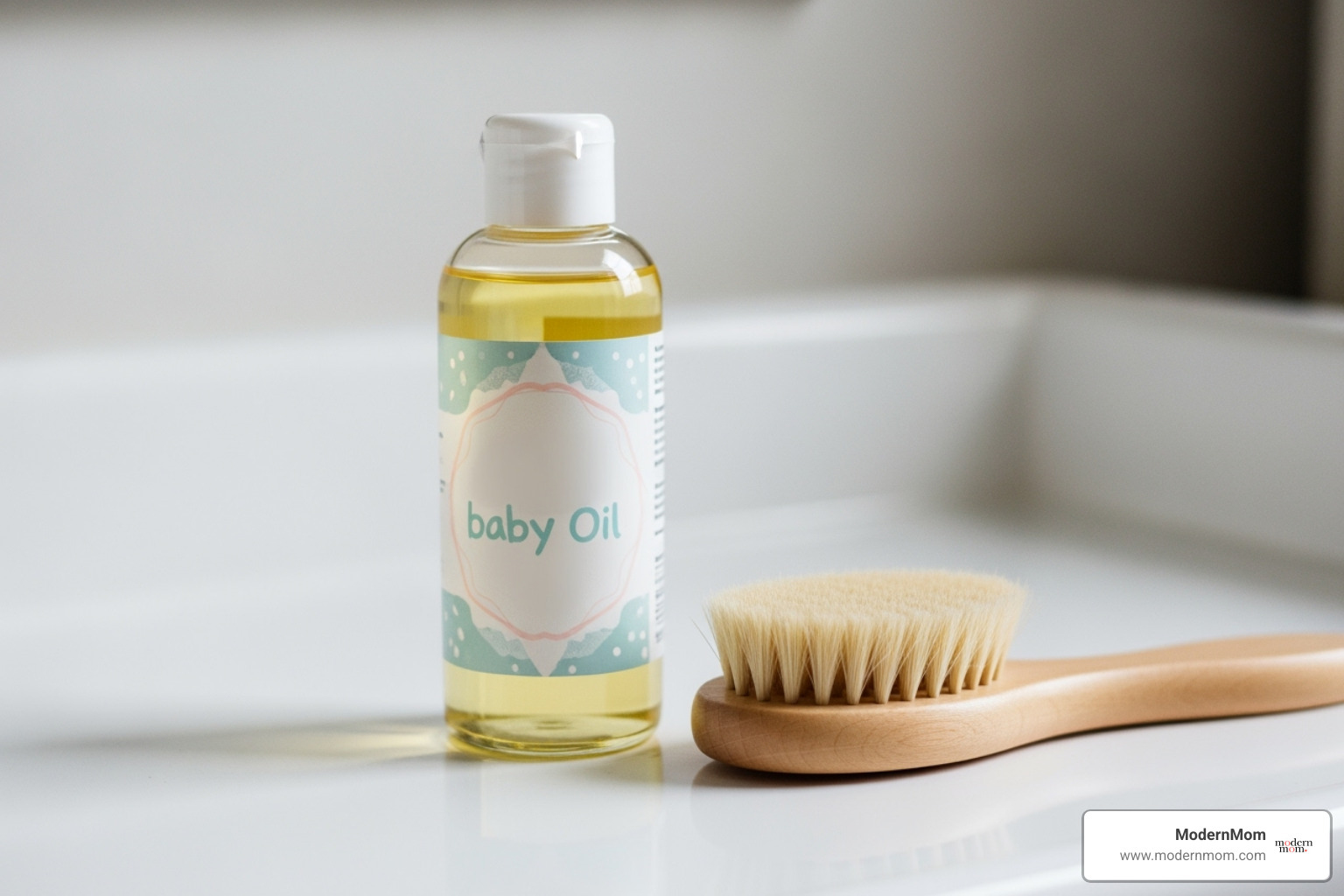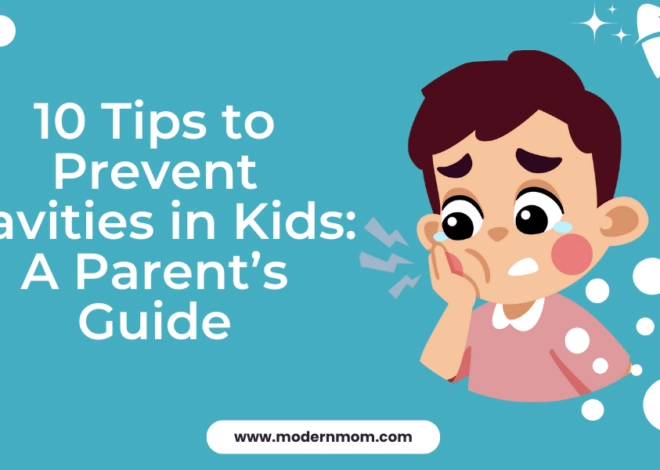Understanding Cradle Cap Before You Treat It
Cradle cap home remedies are gentle, effective ways to manage those yellow, scaly patches on your baby’s scalp. Here are the most trusted methods that work:
Top 5 Cradle Cap Home Remedies:
- Wash and brush gently – Use mild baby shampoo daily and a soft brush to loosen flakes
- Apply natural oils – Coconut oil, mineral oil, or petroleum jelly for 15 minutes before washing
- Try baking soda paste – Mix equal parts baking soda and water, apply briefly, then rinse
- Use chamomile tea rinse – Cool chamomile tea as a gentle scalp rinse after shampooing
- Maintain humidity – Run a humidifier to prevent dry air from worsening the condition
Cradle cap affects about 70% of babies around 3 months old. It’s a harmless form of seborrheic dermatitis that creates those greasy, yellowish scales on your little one’s scalp. The good news? It’s not contagious, doesn’t hurt your baby, and usually clears up by their first birthday.
The condition happens when oil glands produce too much sebum, often triggered by maternal hormones still in your baby’s system. A common yeast called Malassezia may also play a role. While it might look uncomfortable, most babies aren’t bothered by it at all.

What is Cradle Cap and What Causes It?
Imagine your baby’s soft, perfect head suddenly sporting some flaky, sometimes greasy, white or yellow patches. That, dear parents, is usually cradle cap. Medically known as infantile seborrheic dermatitis, it’s a very common skin condition that typically appears on a baby’s scalp. It can look a bit like adult dandruff, but often with thicker, more stubborn scales. The patches might be yellowish, scaly, and even have a mild redness underneath. While the scalp is the most common spot, cradle cap can also make an appearance on your baby’s eyebrows, behind their ears, in neck folds, or even in the armpits or diaper area. It’s not a sign of poor hygiene, nor is it contagious. It simply happens!
So, what exactly causes these peculiar patches? Doctors aren’t entirely sure, but we have some strong theories. One leading idea is that hormones from the mother’s body, which are still circulating in the baby after birth, can cause the baby’s oil glands to produce an excess amount of sebum (natural skin oils). This overproduction of oil, combined with skin cells that aren’t shedding normally, leads to the buildup of those characteristic scales.
Another contributing factor might be a common yeast called Malassezia. This yeast naturally lives on the skin, but when there’s an abundance of oil, it can thrive, potentially leading to inflammation and the formation of cradle cap. It’s a bit like a tiny, harmless ecosystem getting a little out of balance. Rest assured, it’s not due to an allergy or an infection in the typical sense, and it won’t cause your baby any pain or discomfort. It’s just a normal part of their early development as their skin learns to regulate itself. Just like learning to use their hands, a baby’s skin is constantly adapting! More info about baby development.
How Long Does It Last and What are the Symptoms?
The primary symptoms of cradle cap are those distinct flaky, sometimes greasy, white or yellow scales on the scalp. You might also notice some mild redness underneath the patches, especially on lighter skin tones. For babies with darker skin tones, these patches may appear darker than the surrounding skin, purple, or even whitish. Despite how it looks, the most important thing to remember is that cradle cap is usually not itchy. Your baby won’t be scratching their head or showing signs of discomfort or pain. They’ll likely eat, sleep, and play just as happily as ever. If your baby is showing signs of itching or discomfort, it might be something else, which we’ll discuss later.
Now for the good news: cradle cap is typically a temporary visitor! It’s most common in newborns and babies under 3 months old, often starting within the first few weeks of life. While it can persist for a few months, nearly all cases appear during a baby’s first year, and it usually clears up on its own. Most parents find that it resolves by the time their baby is between 6 and 12 months old, with many cases gone by the first birthday. For some, it might linger a bit longer, but cases drastically decrease as a child approaches 4 years of age.
It’s truly a common condition, affecting about 10% of babies under a month old, and then peaking around three months, affecting a significant 70% of infants. So, if your little one has it, they’re definitely not alone! This widespread occurrence reinforces that it’s a benign, self-limiting condition, and a normal part of infancy. For additional guidance straight from the experts, check out these Dermatologist-approved tips for cradle cap.
Step-by-Step Guide to Cradle Cap Home Remedies
When your little one develops those telltale yellow, scaly patches, your first instinct might be to scrub them away. But here’s the thing – gentle is always better when it comes to your baby’s delicate skin. The most effective cradle cap home remedies work by softening those stubborn scales first, then encouraging them to naturally loosen and fall away.
Think of it like this: those scales are like tiny, dried leaves clinging to a tree branch. Rather than pulling them off forcefully (which could damage the branch), we want to create the perfect conditions for them to release on their own. That’s exactly what we’re doing with your baby’s scalp – creating the right environment for healing while protecting that precious, sensitive skin underneath.

The beauty of these home remedies lies in their simplicity. You probably have most of what you need right in your bathroom cabinet or kitchen pantry. And the best part? These methods are not only effective but also create beautiful bonding moments between you and your baby. There’s something incredibly soothing about those gentle massage motions – for both of you.
The Wash and Brush Method: Simple Cradle Cap Home Remedies
This tried-and-true approach is often your best starting point. Daily washing combined with gentle brushing can work wonders, and it’s one of the most reliable cradle cap home remedies you can try at home.
Start your routine even before you turn on the tap. If you’re dealing with particularly stubborn scales, apply a small amount of baby oil or petroleum jelly to your little one’s scalp about 15 minutes before bath time. This pre-treatment step makes everything that follows much more effective.
When it’s time for the actual wash, lukewarm water is your friend – never hot, which can irritate delicate skin. Choose a mild, fragrance-free baby shampoo that’s specifically formulated for infants. Adult shampoos are simply too harsh for your baby’s developing skin barrier.
Here’s where the magic happens: apply that gentle shampoo and massage it in using soft, circular motions with your fingertips. Pay special attention to those scaly areas, but remember to be extra gentle around your baby’s soft spot. This massage isn’t just effective – most babies find it incredibly relaxing.
Now comes the soft brush technique. While the shampoo is still working its magic, take a soft-bristled baby brush (or even a clean, soft toothbrush) and gently brush in circular motions. You’ll be amazed at how easily those loosened flakes start to lift away. The key word here is “lift” – we’re not scrubbing or scraping.
After you’ve worked those scales loose, rinse thoroughly with lukewarm water. This step is crucial, especially if you used any oils beforehand. Any leftover residue can actually make cradle cap worse by trapping dead skin cells.
Finally, pat your baby’s head dry with a soft towel. No vigorous rubbing – just gentle pats.
The golden rules for this method: Be consistent with daily washing during active treatment, always use baby-specific products, and never pick at the flakes with your fingernails. Your patience and gentle persistence will pay off much better than any aggressive approach ever could.
For more creative ideas about managing your little one’s hair as they grow, check out our Tips for your child’s hair.
Applying Oils: A Natural Approach to Cradle Cap Home Remedies
Oil treatments are absolute game-changers when it comes to softening those stubborn cradle cap scales. This natural approach is one of the most beloved cradle cap home remedies among parents, and for good reason – it works beautifully when done correctly.

Coconut oil is often the star of the show here. Virgin coconut oil is particularly wonderful because it’s pure, chemical-free, and has natural antibacterial properties. If it’s solid at room temperature, simply warm a small amount between your palms – it melts beautifully at body temperature.
Mineral oil and petroleum jelly are also excellent choices. They create a protective barrier that locks in moisture and works to soften even the most stubborn crusts. Jojoba oil and sweet almond oil offer gentle, plant-based alternatives that many parents swear by.
The application process is wonderfully simple and creates a lovely bonding experience. Take just a few drops of liquid oil (or a pea-sized amount of coconut oil or petroleum jelly) and apply it directly to the affected areas. Using your fingertips, gently massage the oil into your baby’s scalp for about a minute. Be especially careful around that soft spot – just light, loving touches.
Now comes the waiting game. Let that oil work its magic for 10-15 minutes. For really thick, stubborn patches, you can leave it on longer – even overnight if needed. Some parents find it helpful to place a soft cap on their baby’s head to protect bedding and clothing.
After the soaking time, use your soft brush to gently coax those now-softened flakes away. You’ll be amazed at the difference the oil makes – scales that seemed permanently attached will often lift away effortlessly.
The crucial final step is thorough washing. Use your mild baby shampoo to remove all traces of oil. You might need to shampoo twice to ensure everything’s gone. This isn’t optional – leftover oil can actually trap skin cells and make cradle cap worse.
Before trying any new oil, always do a patch test on a small, less visible area like behind your baby’s ear. Wait 24 hours to make sure there’s no reaction. And here’s an important note: avoid food-based oils like olive oil, which can sometimes feed the yeast that contributes to cradle cap, potentially making things worse.
Other Gentle, Natural Solutions to Consider
Beyond the tried-and-true wash-and-oil methods, there are several other gentle approaches worth considering in your cradle cap home remedies toolkit. Always check with your pediatrician before trying something new – they know your baby’s specific needs best.
Baking soda paste can be surprisingly effective for loosening stubborn scales. Mix equal parts baking soda and water to create a gentle paste. Apply it to affected areas for just a minute or two, then rinse thoroughly before your regular shampooing routine. Be cautious here – baking soda can be drying, so this isn’t an everyday solution.
Chamomile tea rinses offer a wonderfully soothing touch to your routine. Brew a cup of chamomile tea, let it cool completely, then use it as a final rinse after shampooing. Simply pour it gently over your baby’s scalp and pat dry. While the evidence is mostly from happy parents rather than scientific studies, chamomile’s natural soothing properties certainly can’t hurt.
Don’t overlook your home environment either. Running a humidifier in your baby’s room can make a real difference, especially during dry seasons or if you’re using heating or air conditioning frequently. Dry air can worsen skin conditions, so adding moisture to the air supports overall scalp health.
You might hear whispers about using breast milk for cradle cap. While breast milk is incredible for many things, there’s no scientific evidence supporting its use for this condition. It’s generally harmless, but you’ll likely see better results sticking with proven methods.
The key to success with any of these gentler approaches is consistency and patience. Your baby’s skin is still learning how to regulate itself, and with your loving, gentle care, those scales will gradually disappear.
Is It Cradle Cap or Something Else?
As a parent, it’s natural to wonder whether those flaky patches on your baby’s scalp are actually cradle cap or something else entirely. While cradle cap is incredibly common, there are a few other infant skin conditions that can look surprisingly similar at first glance.
The key difference that often helps parents distinguish cradle cap from other conditions is itchiness. True cradle cap typically doesn’t bother babies at all – they won’t scratch, rub, or seem uncomfortable. If your little one is fussing, scratching, or showing signs of irritation, you might be dealing with something else.
Infantile eczema (also called atopic dermatitis) is probably the condition most often confused with cradle cap. Unlike cradle cap’s yellowish, greasy scales that stick mainly to the scalp, eczema tends to create red, inflamed patches that can appear bumpy, crusty, or even oozing. These patches love to show up on your baby’s cheeks, in the creases behind their knees or elbows, and yes, sometimes on the scalp too. The big telltale sign? Eczema is usually itchy, and you’ll notice your baby trying to rub or scratch the affected areas.
Simple dry skin can also create confusion, especially during winter months or in dry climates. However, dry skin typically produces fine, white flakes rather than the thick, waxy, yellowish scales of cradle cap. The skin might look dull or feel tight, and while it can be mildly itchy, it’s nowhere near as greasy or crusty as true cradle cap.
Here’s a quick comparison to help you spot the differences:
| Feature | Cradle Cap | Infantile Eczema | Dry Skin |
|---|---|---|---|
| Appearance | Yellowish, greasy, thick scales; mild redness | Red, inflamed, bumpy patches; crusty or oozing | Fine white flakes; dull, tight-looking skin |
| Itchiness | Usually not itchy; baby unbothered | Often very itchy; baby rubs/scratches | Mildly itchy, but not severe |
| Location | Primarily scalp, eyebrows, behind ears, neck | Cheeks, scalp, elbows, knees, skin creases | Any dry areas; face, hands, legs |
| Texture | Greasy, waxy, thick, crusty | Rough, dry, sometimes weeping or cracked | Flaky, rough, but not greasy or thick |
While rare in babies, psoriasis can occasionally show up as red, scaly patches that might remind you of severe cradle cap. It’s much more common in older children and adults, but it’s worth knowing about. Ringworm is another possibility – and despite its name, it has nothing to do with worms! This fungal infection creates scaly, itchy patches that often have a distinctive ring-like appearance and can cause hair loss in the affected area.
The good news is that most of the time, those flaky patches really are just harmless cradle cap. But when you’re unsure, trust your instincts. If something doesn’t seem right, or if the condition doesn’t match the typical cradle cap description, don’t hesitate to call your pediatrician. Just like learning to distinguish between different childhood ailments, getting an accurate diagnosis helps you choose the right cradle cap home remedies or treatment approach. Is It a Cold or Allergies?
When to Call the Doctor
As a mom myself, I know that moment when you’re staring at your baby’s scalp, wondering if those flakes are just normal cradle cap or something that needs medical attention. While most cases of cradle cap respond beautifully to gentle cradle cap home remedies, there are definitely times when it’s smart to reach out to your pediatrician.

The biggest red flag to watch for is signs of infection. If you notice the affected area becoming increasingly red or swollen, that’s your cue to call. Any oozing, bleeding, or pus-filled bumps on your baby’s scalp should prompt an immediate phone call to your doctor. Trust your nose too – if there’s a foul odor coming from the scalp or if the area feels unusually warm to the touch, these are clear signs that bacteria may have moved in.
Another concern is when your normally content baby suddenly seems uncomfortable or in pain. Typical cradle cap doesn’t itch or hurt. If your little one starts scratching at their head, becomes unusually fussy, or shows other signs of discomfort related to their scalp, it’s time to get professional guidance.
Pay attention to spreading patterns as well. While cradle cap can naturally appear on eyebrows or behind the ears, extensive spreading to the face, neck, or other parts of the body – especially with significant inflammation – warrants a doctor’s visit.
Persistence past one year is another important milestone. If you’ve been consistently trying home treatments and the cradle cap hasn’t improved by your baby’s first birthday, your doctor can offer stronger prescription treatments or rule out other skin conditions that might be masquerading as cradle cap.
Sometimes the condition is just more severe or stubborn than usual. If the scales are extremely thick, cover large areas of the scalp, or simply don’t respond to your best home care efforts after several weeks, professional help can make all the difference.
When you do call your doctor, they’ll want to know how long your baby has had the condition, what treatments you’ve tried, and which products you’ve been using. This information helps them give you the most targeted advice. For comprehensive medical guidance on treatment options, the Expert advice on cradle cap treatment from Mayo Clinic is an excellent resource.
You know your baby best. If something feels off or you’re simply worried, there’s never any harm in making that call. Your pediatrician would much rather reassure you about a normal case of cradle cap than have you worry unnecessarily at home.
Frequently Asked Questions about Cradle Cap
As a mom who’s steerd countless parenting concerns, I know how many questions swirl through your mind when you notice those flaky patches on your baby’s scalp. Let me address the most common worries parents share with me about cradle cap.
Can I prevent my baby from getting cradle cap?
Here’s the honest truth: you can’t completely prevent cradle cap from happening. Since it’s largely caused by hormonal influences from pregnancy that are still affecting your baby’s oil glands, it’s really out of your control. Think of it like your baby’s skin learning to regulate itself – it’s a natural part of their development.
That said, once you know what you’re dealing with, you absolutely can take steps to manage it and prevent it from getting worse. Regular gentle washing with a mild baby shampoo can help prevent excessive buildup of oils and skin cells. Many parents find that brushing their baby’s scalp daily with a soft-bristled brush, even before cradle cap appears, helps keep things moving along nicely.
While you might not be able to prevent it entirely, you can certainly minimize its severity and duration with consistent, gentle care.
Is it safe to pick or scrape the flakes off?
I get it – those flakes are practically calling out to be picked off! But please, resist that urge. It’s never safe to pick or scrape the flakes with your fingernails or any other tool. I know it seems like the quickest solution, but it can actually create bigger problems.
When you pick at the scales, you risk irritating your baby’s delicate scalp and potentially causing small breaks in the skin. These tiny wounds can become entry points for bacteria, leading to infections that will require medical treatment – definitely not what we want!
The beauty of effective cradle cap home remedies is that they work by gently loosening the flakes so they come off naturally during washing and brushing. It takes a bit more patience, but it’s so much safer for your little one’s tender skin.
Will treating cradle cap cause my baby to lose hair?
This is probably one of the biggest fears I hear from parents, and I completely understand why! When you’re gently treating cradle cap, you might notice some hair coming off with the flakes. Before you panic, know that this is completely normal.
The hair that comes away is usually hair that was already trapped within the scales or hair that was ready to shed naturally anyway. Your baby’s hair follicles aren’t being damaged by gentle treatment methods.
The wonderful news is that hair will grow back, often looking healthier once the scalp is clear and can breathe properly. Gentle treatment actually minimizes hair loss compared to letting thick scales build up or, worse, picking at them aggressively.
Babies naturally lose and regrow hair during their first year as their hair patterns establish themselves. A little temporary thinning during cradle cap treatment is just part of the process of getting to that healthy, happy scalp we’re working toward.
Your Guide to a Healthy, Happy Scalp
As we wrap up our journey through cradle cap home remedies, take a deep breath and remember this: you’re doing an amazing job. Those yellow, scaly patches on your baby’s head might look concerning, but they’re just a temporary visitor in your little one’s first year of life.
Patience truly is your superpower when dealing with cradle cap. Most cases resolve completely on their own by the time your baby celebrates their first birthday. The gentle oil treatments, soft brushing, and daily washing we’ve discussed aren’t just about clearing those flakes – they’re about creating precious moments of connection with your baby.
Think about it: every time you massage that coconut oil into their tiny scalp, you’re not just softening stubborn scales. You’re building trust, showing love through touch, and creating a routine that soothes both of you. These quiet moments of care become the foundation of your bond together.
Gentle consistency beats aggressive treatment every time. Your baby’s delicate skin responds best to patient, loving care rather than harsh scrubbing or picking. The wash-and-brush method we shared, combined with natural oils, works because it respects your baby’s developing skin while effectively managing the condition.
Most cradle cap cases clear up naturally as your baby’s oil glands mature and those lingering maternal hormones fade from their system. Your role is simply to support this natural process with tender, consistent care.
At ModernMom, we understand that parenting comes with countless questions and concerns. From managing cradle cap to celebrating developmental milestones, we’re here to guide you through each phase with practical, research-backed advice. Whether you’re dealing with flaky scalps today or planning future hairstyles, check out our More parenting advice for healthy hair for ongoing support.
You’ve got the tools, the knowledge, and most importantly, the love to help your baby achieve a healthy, happy scalp. Trust the process, trust yourself, and enjoy these fleeting moments of early parenthood.





